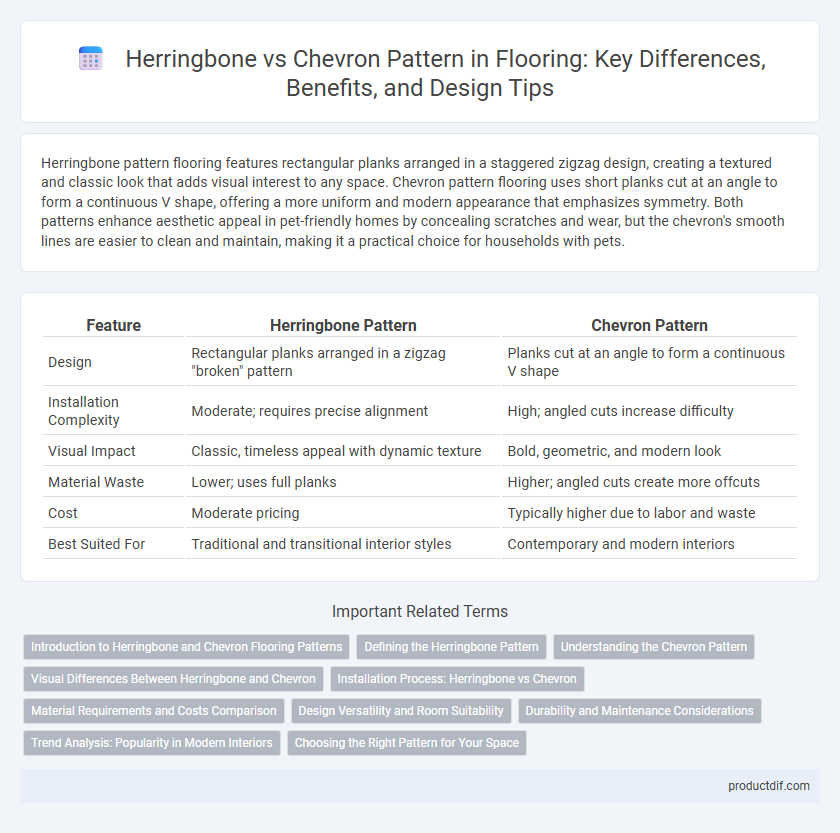Herringbone pattern flooring features rectangular planks arranged in a staggered zigzag design, creating a textured and classic look that adds visual interest to any space. Chevron pattern flooring uses short planks cut at an angle to form a continuous V shape, offering a more uniform and modern appearance that emphasizes symmetry. Both patterns enhance aesthetic appeal in pet-friendly homes by concealing scratches and wear, but the chevron's smooth lines are easier to clean and maintain, making it a practical choice for households with pets.
Table of Comparison
| Feature | Herringbone Pattern | Chevron Pattern |
|---|---|---|
| Design | Rectangular planks arranged in a zigzag "broken" pattern | Planks cut at an angle to form a continuous V shape |
| Installation Complexity | Moderate; requires precise alignment | High; angled cuts increase difficulty |
| Visual Impact | Classic, timeless appeal with dynamic texture | Bold, geometric, and modern look |
| Material Waste | Lower; uses full planks | Higher; angled cuts create more offcuts |
| Cost | Moderate pricing | Typically higher due to labor and waste |
| Best Suited For | Traditional and transitional interior styles | Contemporary and modern interiors |
Introduction to Herringbone and Chevron Flooring Patterns
Herringbone and Chevron flooring patterns are popular choices for adding visual interest and texture to interior spaces, each featuring distinct geometric layouts. Herringbone consists of rectangular planks arranged in a staggered zigzag pattern resembling a fish skeleton, while Chevron employs angled planks joined to create a continuous V shape. These patterns enhance hardwood, laminate, and engineered flooring installations by offering timeless elegance and dynamic aesthetics in residential and commercial settings.
Defining the Herringbone Pattern
The herringbone pattern features rectangular wood planks arranged in a staggered zigzag design, creating a distinctive broken zigzag appearance. Each plank is laid at a 90-degree angle to the next, forming a repetitive V-shape with an offset alignment. This classic pattern adds visual texture and depth to flooring, often used in hardwood, tile, and laminate installations for a timeless, elegant look.
Understanding the Chevron Pattern
The Chevron pattern features planks cut at an angle, typically 45 degrees, creating a continuous V-shaped zigzag design known for its seamless, sharp lines. This style enhances the visual flow of flooring by guiding the eye along the repeating chevrons, making spaces appear larger and more dynamic. Distinct from the Herringbone pattern, Chevron's precise angled cuts require exact installation, offering a sleek and modern look favored in both traditional and contemporary interiors.
Visual Differences Between Herringbone and Chevron
The herringbone pattern features rectangular planks arranged in a zigzag formation with staggered ends, creating a broken, textured appearance that adds depth and dimension to flooring. In contrast, the chevron pattern uses planks cut at an angle and aligned to form a continuous "V" shape, producing a seamless, sleek, and more geometric visual effect. These distinct arrangements influence room aesthetics by either emphasizing intricate detail with herringbone or a bold, streamlined look with chevron.
Installation Process: Herringbone vs Chevron
Herringbone flooring requires precise, staggered placement of rectangular planks at 90-degree angles, creating a zigzag effect that demands careful measurement and alignment during installation. Chevron flooring involves cutting the ends of planks at an angle to form a continuous V shape, which can require more intricate craftsmanship and precise cutting tools to ensure perfect joinery. Both patterns demand skilled labor, but Chevron installation typically takes more time and expertise due to the complexity of angled cuts and seamless joins.
Material Requirements and Costs Comparison
Herringbone pattern flooring typically requires standard rectangular planks and less precise cutting, making material costs more affordable compared to the chevron pattern, which demands custom-cut, angled planks for a seamless V-shaped design, increasing both material waste and expenses. The chevron pattern's precision cuts often lead to higher labor costs and longer installation times, while herringbone's simpler geometry allows for more efficient use of available materials and faster application. Choosing between these patterns impacts overall project budgeting primarily due to differences in material waste, cut complexity, and labor intensity.
Design Versatility and Room Suitability
Herringbone pattern flooring offers timeless sophistication and works well in both traditional and contemporary interiors, enhancing rooms with moderate to high foot traffic such as living rooms and hallways. Chevron pattern flooring provides a more dynamic and modern visual appeal, ideal for smaller spaces like bedrooms and offices where the angled design creates an illusion of expanded area. Both patterns complement hardwood, laminate, and vinyl materials, delivering design versatility that adapts to various architectural styles and room sizes.
Durability and Maintenance Considerations
Herringbone and Chevron patterns both offer durable flooring options, with engineered hardwood and high-quality laminate materials enhancing longevity. The interlocking design of Chevron provides slightly better resistance to shifting and wear under heavy foot traffic. Maintenance for both requires regular sweeping and occasional refinishing for hardwood, while laminate versions need only damp mopping and minimal upkeep to preserve their appearance.
Trend Analysis: Popularity in Modern Interiors
Herringbone pattern flooring maintains strong popularity in modern interiors due to its timeless, classic appeal and versatility in various wood finishes. Chevron pattern flooring is favored for contemporary spaces, offering a sleek, geometric design that enhances visual interest and complements minimalist aesthetics. Current trend analysis indicates a growing preference for herringbone in traditional and transitional homes, while chevron gains traction in high-end, modern residential and commercial projects.
Choosing the Right Pattern for Your Space
Herringbone patterns create a classic, staggered effect with rectangular planks offset at 90 degrees, ideal for adding texture and visual interest in both traditional and modern interiors. Chevron patterns feature V-shaped planks with angled ends meeting precisely, offering a sleek, contemporary look that enhances room length and openness. Selecting between herringbone and chevron depends on desired aesthetic impact, room size, and the flooring material, with herringbone suiting versatile spaces and chevron providing a bold, geometric statement.
Herringbone Pattern vs Chevron Pattern Infographic

 productdif.com
productdif.com